The Spatio-Temporal Impact of Land Use Changes on Runoff in the Yiluo River Basin Based on the SWAT and PLUS Model
Abstract
1. Introduction
2. Materials and Methods
2.1. Overview of the Study Area
2.2. Data Source
2.3. Data Processing
2.4. SWAT Model and Its Construction
2.5. PLUS Model
2.6. Sensitivity Analysis and Selection of Key Parameters
3. Results
3.1. Model Calibration and Validation Results
3.2. Land Use Change
3.3. Response of Runoff to Land Use Change
3.4. Land Use and Runoff Prediction
4. Discussion
4.1. Applicability of the SWAT Model in the Yiluo River Basin
4.2. Watershed Management
4.3. Limitations
5. Conclusions
- (1)
- Using land use, soil-type, and meteorological data from 2000 to 2020, a SWAT model was developed for the Yiluo River Basin. Both the NS and the R2 values exceeded 0.8 during the calibration and validation periods, indicating that the model performs well in simulating hydrological processes in the basin.
- (2)
- A PLUS model was developed for the Yiluo River Basin, with a Kappa coefficient of 0.91, demonstrating high accuracy and strong reliability in simulating land use changes.
- (3)
- Between 2000 and 2020, the Yiluo River Basin experienced notable land use changes. Forest, WATR, and URBN areas increased by 795.15 km2, 29.33 km2, and 573.67 km2, respectively, while URBN and PAST areas declined by 814.50 km2 and 583.89 km2. These changes reflect a significant shift in land use structure and highlight the accelerating process of urbanization in the region.
- (4)
- In the Yiluo River Basin, the annual average runoff depth shows a clear pattern of being higher in the upstream and lower in the downstream. Increases in FRST and PAST help suppress runoff, while the expansion of URBN tends to enhance it.
- (5)
- In 2025 and 2030, land use in the Yiluo River Basin will still be primarily composed of arable land and forest. The annual average runoff is expected to increase by 0.42% and 0.51%, respectively, compared to in 2020.
Author Contributions
Funding
Data Availability Statement
Acknowledgments
Conflicts of Interest
References
- Winkler, K.; Fuchs, R.; Rounsevell, M.; Herold, M. Global land use changes are four times greater than previously estimated. Nat. Commun. 2021, 12, 2501. [Google Scholar] [CrossRef]
- Chen, C. Impacts of land use/land cover change and climate change on the runoff in Yuan River basin based on SWAT model. Sci. Soil Water Conserv. 2020, 18, 52–59. [Google Scholar]
- Kindu, M.; Schneider, T.; Döllerer, M.; Yang, F.; Zuo, Q. Scenario modelling of land use/land cover changes in Munessa-Shashemene landscape of the Ethiopian highlands. Sci. Total Environ. 2018, 622, 534–546. [Google Scholar] [CrossRef] [PubMed]
- Zeng, S.; Xia, J.; Du, H.; Zhang, L.; Chen, X.; Wang, R.; Aditya, S. Effects of climate change, land use and cover change and CO2 enrichment on runoff: A case study of the Luanhe River basin. Adv. Water Sci. 2014, 25, 10–20, (Chinese with English abstract). [Google Scholar]
- Zhang, T.; Chen, Y.; Li, Q. Effects of land-use change on the spatio-temporal patterns of runoff and sediment in the Danjiang River Basin. Resour. Environ. Yangtze Basin 2022, 31, 1797–1811, (Chinese with English abstract). [Google Scholar]
- Yonaba, R.; Biaou, A.C.; Koïta, M.; Tazen, F.; Mounirou, L.A.; Zouré, C.O.; Queloz, P.; Karambiri, H.; Yacouba, H. A dynamic land use/land cover input helps in picturing the Sahelian paradox: As-sessing variability and attribution of changes in surface runoff in a Sahelian watershed. Sci. Total Environ. 2021, 757, 143792. [Google Scholar] [CrossRef]
- Shi, Y.; Wang, J.; Cheng, F.; Wang, Y.; Luo, Z.; Guo, H. Variation trend and attribution identification of runoff in Xichuan River Basin in loess hilly and gully region in recent 50 years. Sci. Soil Water Conserv. 2024, 22, 51–58, (Chinese with English abstract). [Google Scholar]
- Liu, X.; Zhang, H.; Luo, Z.; Zhang, J.; An, N. Response of runoff and sediment yields to land use change in Fu River watershed based on SWAT model. Res. Soil Water Conserv. 2024, 31, 79–89, (Chinese with English abstract). [Google Scholar]
- Dash, S.S.; Naik, B.; Kashyap, P.S. Assessment of land use/ land cover change derived catchment hydrologic response: An integrated parsimonious hydrological modeling and alteration analysis based approach. J. Environ. Manag. 2024, 2024, 356. [Google Scholar] [CrossRef]
- Ezimand, K.; Aghighi, H.; Ashourloo, D.; Shakiba, A. The analysis of the spatio-temporal changes and prediction of URBNs and urban heat islands using multi-temporal satellite imagery. Sustain. Cities Soc. 2024, 103, 105231. [Google Scholar] [CrossRef]
- Shao, Z.; Chen, R.; Zhao, J.; Xia, C.; He, Y.; Tang, F. Spatio-temporal evolution and prediction of carbon storage in Beijing’s ecosystem based on FLUS and InVEST models. Acta Ecol. Sin. 2022, 42, 9456–9469, (Chinese with English abstract). [Google Scholar]
- Li, H.; Chen, G.; Wang, S.; Zhang, Z.; Zhang, Z.; Jin, H. Suitability evaluation of AGRL in Naoli River Basin based on CLUE-S scenario simulation. Trans. Chin. Soc. Agric. Mach. 2023, 54, 329–339, (Chinese with English abstract). [Google Scholar]
- Zhou, Y.; Qin, T.; Pei, Y.; Gao, Y.; Guan, Y.N.; Kou, F.J. Land use simulation and multi-scenario prediction based on PLUS model and ground substrate. Geol. Rev. 2024, 70 (Suppl. S1), 315–318, (Chinese with English abstract). [Google Scholar]
- Yonaba, R.; Koïta, M.; Mounirou, L.A.; Tazen, F.; Queloz, P.; Biaou, A.C.; Niang, D.; Zouré, C.; Karambiri, H.; Yacouba, H. Spatial and transient modelling of land use/land cover (LULC) dynamics in a Sahelian landscape under semi-arid climate in northern Burkina Faso. Land Use Policy 2021, 103, 105305. [Google Scholar] [CrossRef]
- Jiang, X.; Duan, H.; Liao, J.; Song, X.; Xue, X. Land use in the Gan-Lin-Gao region of middle reaches of Heihe River Basin based on a PLUS-SD coupling model. Arid. Zone Res. 2022, 39, 1246–1258, (Chinese with English abstract). [Google Scholar]
- Xu, H.; Shi, N.; Wu, L.; Zhang, D. Measurement of high-quality development level and its spatiotemporal evolution in the Yellow River Basin. Resour. Sci. 2020, 42, 115–126, (Chinese with English abstract). [Google Scholar]
- Liu, J.; Huang, L.; Zuo, Q. Evaluation of harmonious development of economy-population-resource-environment in the lower reaches of the Yellow River. Resour. Sci. 2021, 43, 412–422, (Chinese with English abstract). [Google Scholar]
- Ni, Y.; Yu, Z.; Lv, X.; Ma, L.; Zhang, Q.; Wang, J. Analysis on attribution of runoff evolution in Yiluo River basin in the past 50 years. J. Hydraul. Civ. Eng. 2022, 2022, 59–66, (Chinese with English abstract). [Google Scholar]
- Zhang, J. Study on soil conservation function of Yiluo River Basin based on InVEST model. Henan Sci. Technol. 2023, 42, 86–90, (Chinese with English abstract). [Google Scholar]
- Liang, G. Landscape Dynamics and Runoff Effects in the Yiluo River Basin. Ph.D. Thesis, Henan University, Kaifeng, China, 2010. (Chinese with English abstract). [Google Scholar]
- Wang, Z.; Shang, R.; Chen, H.; Ma, M. Analysis of water quality change trend of Yiluo River based on Kendall test method. J. North China Univ. Water Resour. Electr. Power (Nat. Sci. Ed.) 2021, 42, 17–23, (Chinese with English abstract). [Google Scholar]
- Almeida, M.; Coelho, P. Improving the accuracy of an integrated watershed-reservoir water quality modeling approach (SWAT and CE-QUAL-W2) in data scarce watersheds. J. Hydrol. 2024, 644, 132076. [Google Scholar] [CrossRef]
- Wang, Y.; Chen, Y.; Lu, W.; Tian, Y. The hydrological response to different land use scenarios in the Minjiang River Basin. J. Soil Water Conserv. 2020, 34, 30–36, (Chinese with English abstract). [Google Scholar]
- Zhao, N.; Gao, F.; Qin, L.; Sang, C.; Yao, Z.; Liu, B.; Zhang, M. Simulated Multi-Scenario Analysis of Land Use and Carbon Stock Dynamics in the Yiluo River Basin Using the PLUS-InVEST Model. Sustainability 2025, 17, 1233. [Google Scholar] [CrossRef]
- Arnold, J.G.; Moriasi, D.N.; Gassman, P.W.; Abbaspour, K.C.; White, M.J.; Srinivasan, R.; Santhi, C.; Harmel, R.D.; van Griensven, A.; Van Liew, M.W.; et al. SWAT: Model use, calibration, and validation. Trans. ASABE 2012, 55, 1491–1508. [Google Scholar] [CrossRef]
- Gassman, P.W.; Reyes, M.R.; Green, C.H.; Arnold, J.G. The soil and water assessment tool: Historical development, applications, and future research directions. Trans. ASABE 2007, 50, 1211–1250. [Google Scholar] [CrossRef]
- Cheng, X.; Wang, H.; Chen, B.; Li, Z.; Zhou, J. Comparative analysis of flood prevention and control at LID facilities with runoff and flooding as control objectives based on InfoWorks ICM. Water 2024, 16, 374. [Google Scholar] [CrossRef]
- Špitalar, M.; Gourley, J.J.; Lutoff, C.; Kirstetter, P.E.; Brilly, M.; Carr, N. Analysis of flash flood parameters and human impacts in the US from 2006 to 2012. J. Hydrol. 2014, 519, 863–870. [Google Scholar] [CrossRef]
- Piao, S.; Ciais, P.; Huang, Y.; Shen, Z.; Peng, S.; Li, J.; Zhou, L.; Liu, H.; Ma, Y.; Ding, Y.; et al. The impacts of climate change on water resources and agriculture in China. Nature 2010, 467, 43–51. [Google Scholar] [CrossRef]
- Zhang, L.; Dawes, W.R.; Walker, G.R. Response of mean annual evapotranspiration to vegetation changes at catchment scale. Water Resour. Res. 2001, 37, 701–708. [Google Scholar] [CrossRef]
- Jiang, N.; Ni, F.; Deng, Y.; Wu, M.; Yue, Z.; Zhu, M.; Ren, H.; Wang, Y. The impact of future climate and land use changes on runoff in the Min-Tuo River Basin. J. Water Clim. Change 2024, 15, 5518–5539. [Google Scholar] [CrossRef]
- Yang, H.; Luo, P.; Wang, J.; Mou, C.; Mo, L.; Wang, Z.; Fu, Y.; Lin, H.; Yang, Y.; Bhatta, L.D. Ecosystem evapotranspiration as a response to climate and vegetation coverage changes in Northwest Yunnan, China. PLoS ONE 2015, 10, e0134795. [Google Scholar] [CrossRef] [PubMed]
- Song, X.; Zhang, J.; Zhan, C.; Liu, C. Review for impacts of climate change and human activities on water cycle. J. Hydraul. Eng. 2013, 44, 779–790, (Chinese with English abstract). [Google Scholar]
- Chen, C.; Gan, R.; Feng, D.; Yang, F.; Zuo, Q. Quantifying the contribution of SWAT modeling and CMIP6 inputting to streamflow prediction uncertainty under climate change. J. Clean. Prod. 2022, 364, 132675. [Google Scholar] [CrossRef]
- Chen, J.; Du, C.; Nie, T.; Han, X.; Tang, S. Study of non-point pollution in the Ashe River Basin based on SWAT model with different land use. Water 2022, 14, 2177. [Google Scholar] [CrossRef]
- Guo, P.; Wang, Y.; Yan, Y.; Wang, F.; Lyu, J.; Ge, W.; Chen, H.; Jiao, J. Assessing the Spatiotemporal Variations in the Hydrological Response of the Qin River Basin in Loess Plateau, China. Remote Sens. 2024, 16, 1603. [Google Scholar] [CrossRef]
- Noori, N.; Kalin, L.; Isik, S. Water quality prediction using SWAT-ANN coupled approach. J. Hydrol. 2020, 590, 125220. [Google Scholar] [CrossRef]
- Liang, Z.; Tang, T.; Li, B.; Liu, T.; Wang, J.; Hu, Y. Long-term streamflow forecasting using SWAT through the integration of the random forests precipitation generator: Case study of Danjiangkou Reservoir. Hydrol. Res. 2018, 49, 1513–1527. [Google Scholar] [CrossRef]
- Waheed, A.; Jamal, M.H.; Javed, M.F.; Muhammad, K.I. A CMIP6 multi-model based analysis of potential climate change effects on watershed runoff using SWAT model: A case study of kunhar river basin, Pakistan. Heliyon 2024, 10, e28951. [Google Scholar] [CrossRef]
- Sitterson, J.; Knightes, C.; Parmar, R.; Wolfe, K.; Avant, B.; Muche, M. An overview of rainfall-runoff model types. 2018. In Proceedings of the 9th International Congress on Environmental Modelling and Software, Ft. Collins, CO, USA, 24–28 June 2018. [Google Scholar]
- Asadi, S.; Jimeno-Sáez, P.; López-Ballesteros, A.; Senent-Aparicio, J. Comparison and integration of physical and interpretable AI-driven models for rainfall-runoff simulation. Results Eng. 2024, 24, 103048. [Google Scholar] [CrossRef]
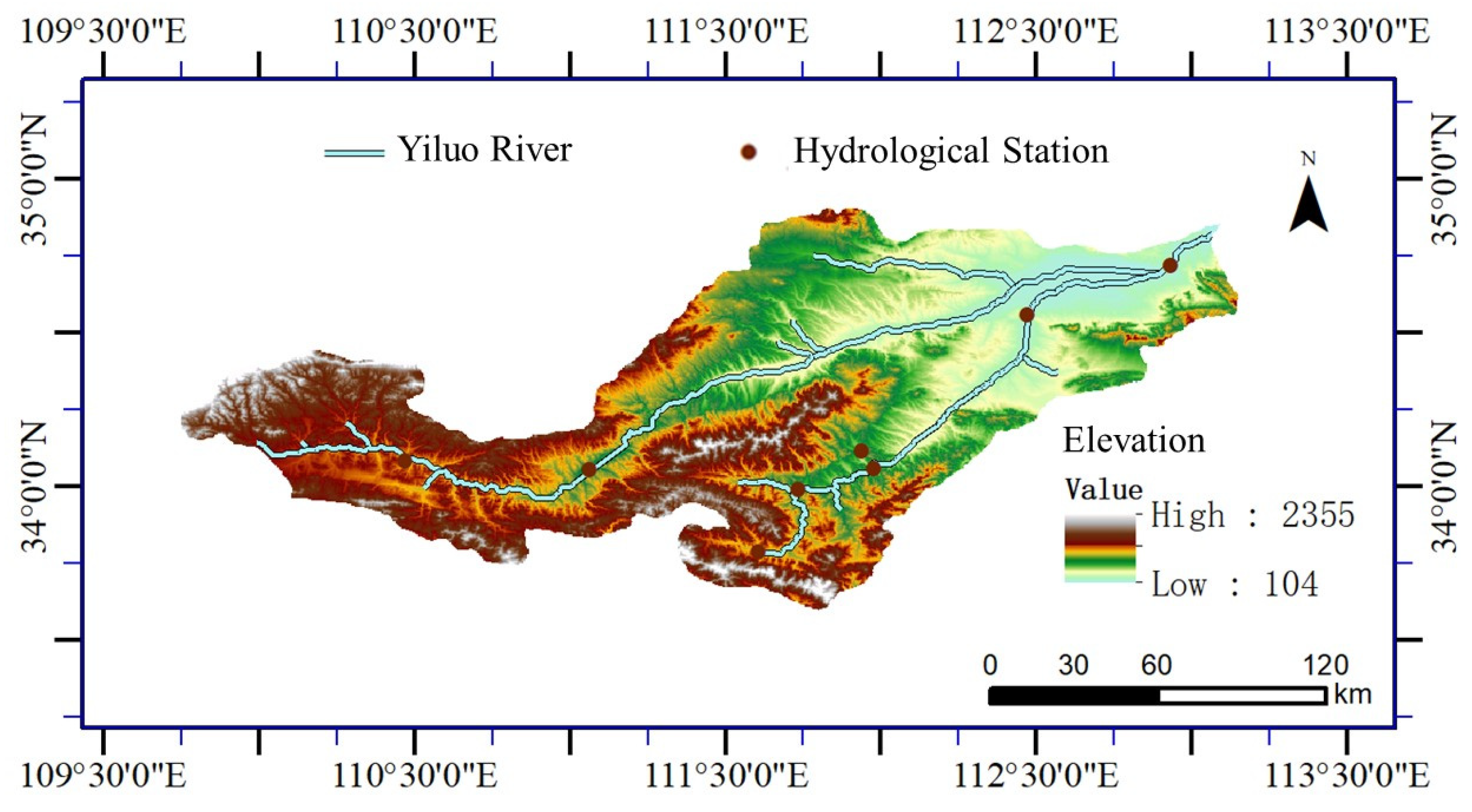
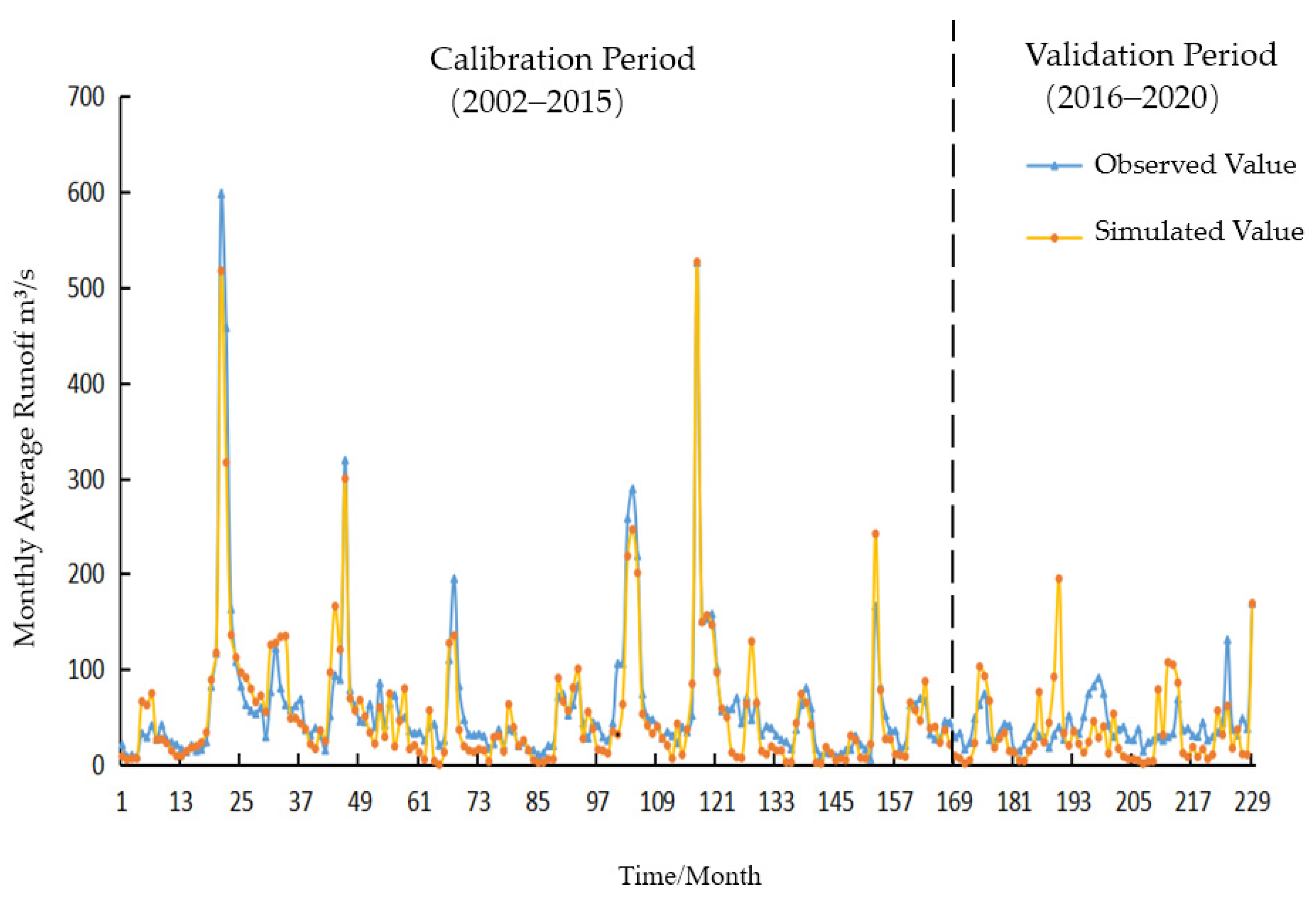

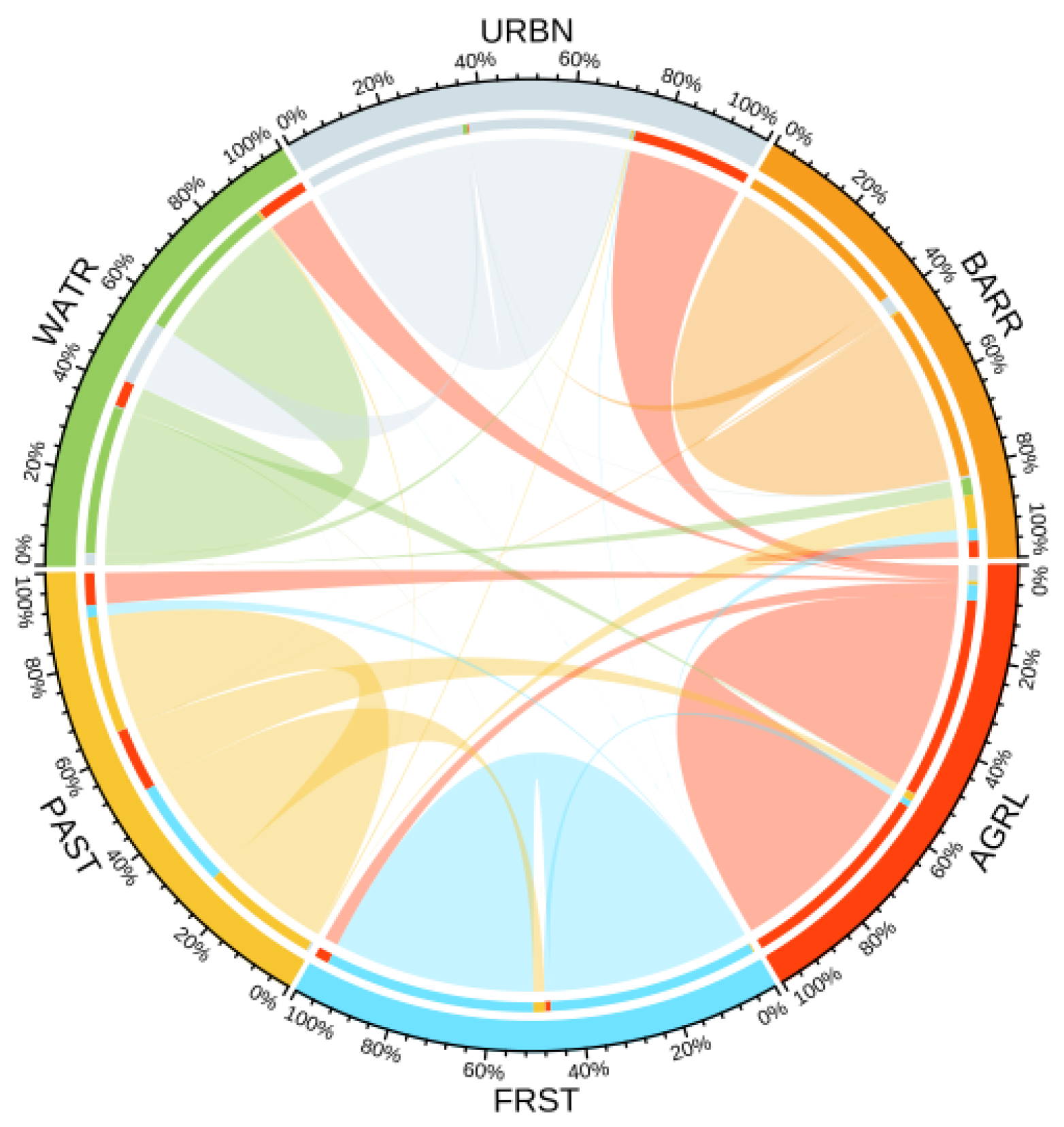
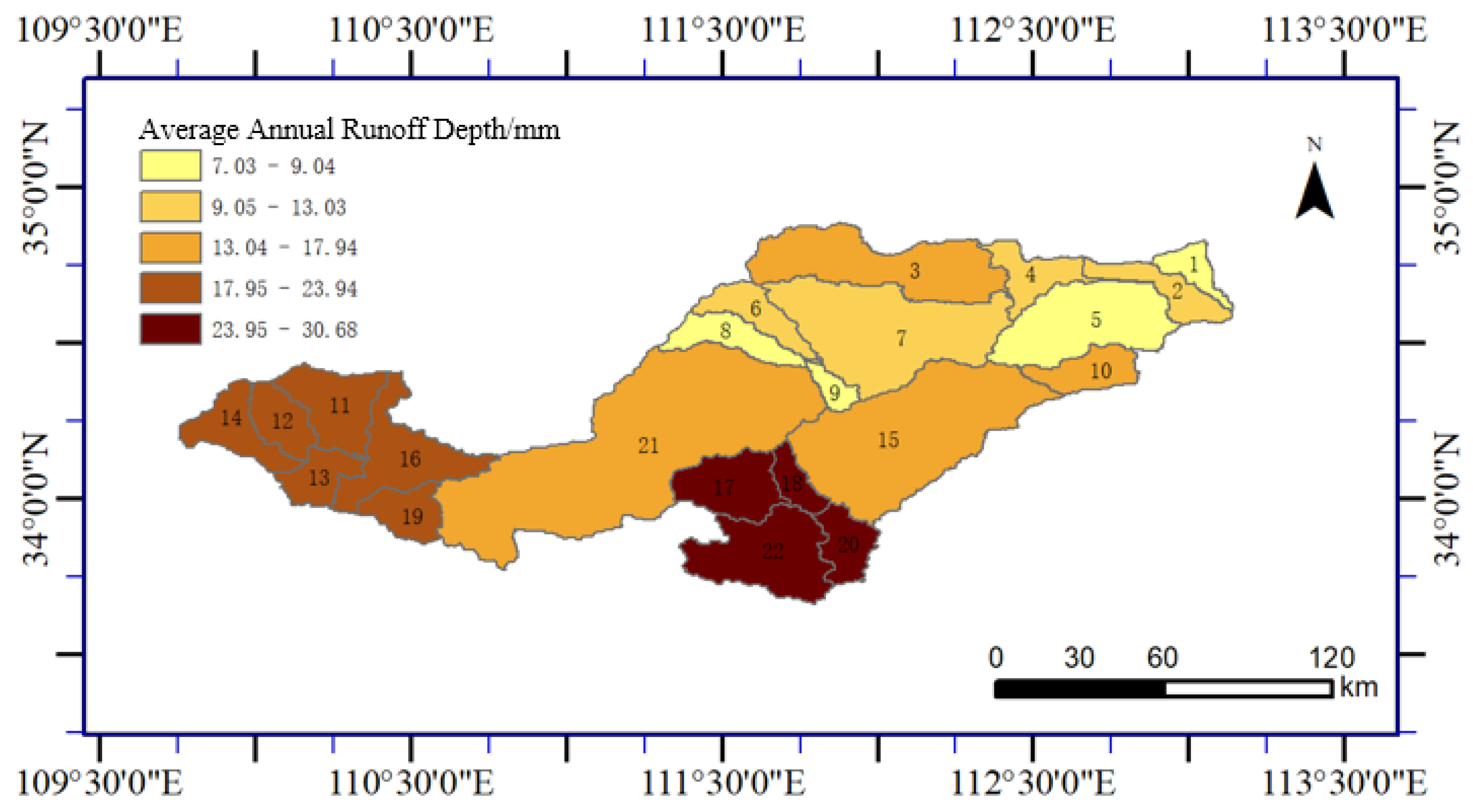
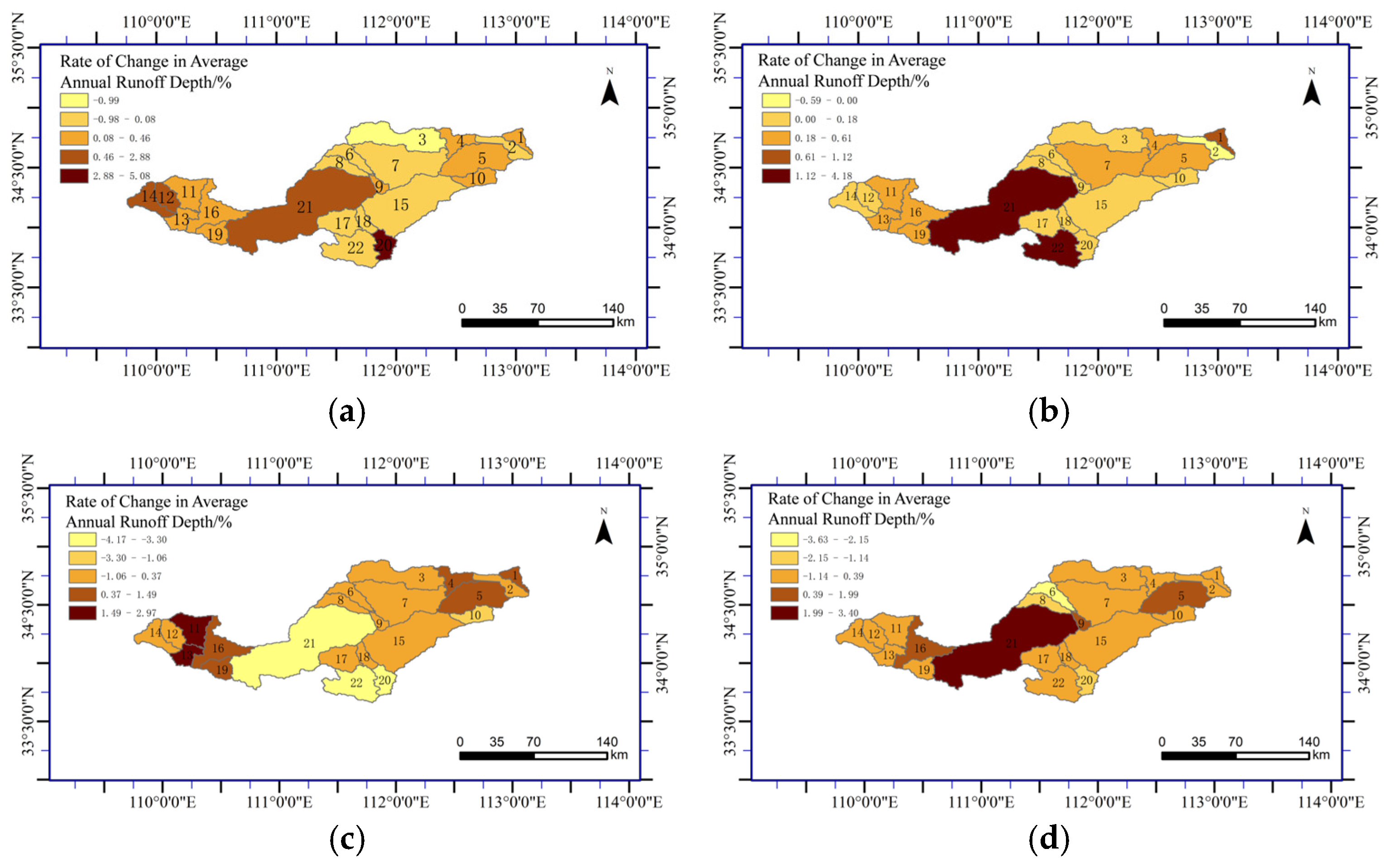


| Data Name | Data Accuracy | Data Source | Data Year |
|---|---|---|---|
| Land use data | 30 m | Resource and Environmental Science Data Platform (http://www.resdc.cn (accessed on 5 April 2024)) | 2020 |
| DEM | 30 m | Geospatial Data Cloud (www.gscloud.cn) | 2000–2020 |
| Soil type | 1 km | Harmonized World Soil Database (https://gaez.fao.org/pages/hwsd) (accessed on 5 April 2024) | 2009 |
| Meteorological data | daily scale | The National Meteorological Data Center (https://data.cma.cn/ (accessed on 5 April 2024)) | 2000–2020 |
| Runoff data | monthly scale | The National Earth System Science Data Center and The Yellow River Conservancy Commission (http://www.geodata.cn/main/ http://www.yrcc.gov.cn/ (accessed on 5 April 2024)) | 2000–2020 |
| Data Type | Data Name | Data Description |
|---|---|---|
| Natural factors | DEM | Direct input |
| Slope | Calculated from DEM | |
| Aspect | Calculated from DEM | |
| Soil type | Direct input | |
| Social factors | Distance to roads | Euclidean distance |
| Distance to railways | Euclidean distance | |
| Distance to residential areas | Euclidean distance | |
| Distance to WATR | Euclidean distance | |
| Population density | Resampled to 30 m resolution |
| Serial Number | Parameter Name | Optimal Value |
|---|---|---|
| 1 | v__GW_DELAY.gw | 268.559448 |
| 2 | v__REVAPMN.gw | −33.110527 |
| 3 | v__ALPHA_BF.gw | 25.127949 |
| 4 | r__SOL_K.sol | −20.801529 |
| 5 | v__ESCO.hru | 15.403322 |
| 6 | r__ALPHA_BNK.rte | −14.272413 |
| 7 | v__CANMX.hru | 11.714357 |
| 8 | v__SURLAG.bsn | 9.826532 |
| 9 | v__CH_N2.rte | 8.715669 |
| 10 | v__GW_REVAP.gw | 8.035896 |
| 11 | r__SOL_AWC.sol | 4.97311 |
| 12 | v__GWQMN.gw | −4.388701 |
| 13 | v__CH_K2.rte | −3.759947 |
| 14 | r__SOL_BD.sol | −1.236726 |
| 15 | r__OV_N.hru | 0.123613 |
| 16 | r__CN2.mgt | 0.103597 |
| Period | Time | Site | Measured Value (m3/s) | Simulated Value (m3/s) | NS | R2 |
|---|---|---|---|---|---|---|
| Calibration Period | 2002–2015 | Heishiguan | 61.75 | 56.74 | 0.89 | 0.89 |
| Validation Period | 2016–2020 | Heishiguan | 33.95 | 32.89 | 0.82 | 0.83 |
| Year | 2000 | 2005 | 2010 | 2015 | 2020 | Actual |
|---|---|---|---|---|---|---|
| 2002–2015 | 56.54 | 56.67 | 56.74 | 57.31 | 57.64 | 61.75 |
| 2016–2020 | 32.53 | 32.72 | 32.9 | 33.52 | 33.66 | 38.71 |
| 2002–2020 | 50.22 | 50.37 | 50.47 | 51.05 | 51.33 | 55.69 |
| Sub-Basin | Land Use Type | Initial Area Proportion (%) | Final Area Proportion (%) | Change |
|---|---|---|---|---|
| 20 | AGRL | — | 8.52 | 8.52 |
| FRST | 100 | 90.3 | −9.7 | |
| PAST | — | 0.97 | 0.97 | |
| WATR | — | — | — | |
| URBN | — | 0.21 | 0.21 | |
| BARR | — | — | — | |
| 22 | AGRL | 7.99 | 7.85 | −0.14 |
| FRST | 88.85 | 87.97 | −0.88 | |
| PAST | 2.38 | 2.58 | 0.2 | |
| WATR | 0.03 | 0.02 | −0.01 | |
| URBN | 0.77 | 1.6 | 0.83 | |
| BARR | — | — | — | |
| 11 | AGRL | 12.5 | 12.2 | −0.3 |
| FRST | 76.77 | 79.1 | 2.33 | |
| PAST | 10.5 | 8.45 | −2.05 | |
| WATR | — | — | — | |
| URBN | 0.25 | 0.27 | 0.02 | |
| BARR | — | — | — | |
| 21 | AGRL | 29.46 | 29.49 | 0.03 |
| FRST | 57.43 | 61.3 | 3.87 | |
| PAST | 10.57 | 6.39 | −4.18 | |
| WATR | 0.38 | 0.4 | 0.02 | |
| URBN | 2.16 | 2.42 | 0.26 | |
| BARR | 0.01 | 0.01 | — |
Disclaimer/Publisher’s Note: The statements, opinions and data contained in all publications are solely those of the individual author(s) and contributor(s) and not of MDPI and/or the editor(s). MDPI and/or the editor(s) disclaim responsibility for any injury to people or property resulting from any ideas, methods, instructions or products referred to in the content. |
© 2025 by the authors. Licensee MDPI, Basel, Switzerland. This article is an open access article distributed under the terms and conditions of the Creative Commons Attribution (CC BY) license (https://creativecommons.org/licenses/by/4.0/).
Share and Cite
Zhao, N.; Gao, F.; Ma, K.; Teng, Y.; Wan, H.; Wang, J. The Spatio-Temporal Impact of Land Use Changes on Runoff in the Yiluo River Basin Based on the SWAT and PLUS Model. Water 2025, 17, 1516. https://doi.org/10.3390/w17101516
Zhao N, Gao F, Ma K, Teng Y, Wan H, Wang J. The Spatio-Temporal Impact of Land Use Changes on Runoff in the Yiluo River Basin Based on the SWAT and PLUS Model. Water. 2025; 17(10):1516. https://doi.org/10.3390/w17101516
Chicago/Turabian StyleZhao, Na, Feilong Gao, Kun Ma, Yanzhen Teng, Hanli Wan, and Junbo Wang. 2025. "The Spatio-Temporal Impact of Land Use Changes on Runoff in the Yiluo River Basin Based on the SWAT and PLUS Model" Water 17, no. 10: 1516. https://doi.org/10.3390/w17101516
APA StyleZhao, N., Gao, F., Ma, K., Teng, Y., Wan, H., & Wang, J. (2025). The Spatio-Temporal Impact of Land Use Changes on Runoff in the Yiluo River Basin Based on the SWAT and PLUS Model. Water, 17(10), 1516. https://doi.org/10.3390/w17101516






